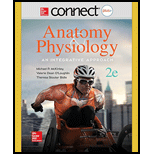
A splanchnic nerve in the sympathetic division of the ANS
- a. connects neighboring sympathetic trunk ganglia.
- b. controls parasympathetic functions in the thoracic cavity.
- c. is formed by preganglionic axons that extend to prevertebral ganglia.
- d. travels through parasympathetic pathways in the head.
Introduction:
The motor component of the ANS (autonomic nervous system) is divided into the sympathetic division and the parasympathetic division. The sympathetic division is complex anatomically then the parasympathetic one. Sympathetic division is also called as the thoracolumbar division.
Answer to Problem 1DYKB
Correct answer:
In the sympathetic division of ANS, a splanchnic nerve is formed by the axons (preganglionic) and which extends till the prevertebral ganglia. Therefore, option c. is correct.
Explanation of Solution
Reason for the correct statement:
Option c. is given as “is formed by preganglionic axons that extend to prevertebral ganglia”. The splanchnic nerves of the sympathetic division run anteriorly from the trunk (sympathetic) to most of the pelvic and abdominal viscera. These nerves (splanchnic) possess the preganglionic axons, which begins from the trunk ganglia and reaches to the aortic wall’s prevertebral ganglia. Hence, the splanchnic nerve is formed by the axons and extends till the prevertebral ganglia.
Hence, option c. is correct.
Reasons for incorrect statements:
Option a. is given as “connects neighboring sympathetic trunk ganglia”. The splanchnic nerve does not connect the neighboring ganglia. Hence, option a. is incorrect.
Option b. is given as “connects parasympathetic functions in the thoracic cavity”. The parasympathetic preganglionic axons are branched in forming the pelvic splanchnic nerves. Hence, option b. is incorrect.
Option d. is given as “travels through parasympathetic pathways in the head”. The sympathetic splanchnic nerve runs from the trunk ganglion (sympathetic) to the prevertebral ganglia. The parasympathetic splanchnic nerves forms the pelvic splanchnic nerves. Hence, option d. is incorrect.
Hence, options a., b., and d. are incorrect.
The splanchnic nerves are formed by those axons, which extends to the prevertebral ganglia. Thus, from the ganglionic origins, these nerves innervate the organs of the body.
Want to see more full solutions like this?
Chapter 15 Solutions
Connect Access Card for Anatomy & Physiology
Additional Science Textbook Solutions
Chemistry: An Introduction to General, Organic, and Biological Chemistry (13th Edition)
College Physics: A Strategic Approach (3rd Edition)
The Cosmic Perspective (8th Edition)
Laboratory Manual For Human Anatomy & Physiology
SEELEY'S ANATOMY+PHYSIOLOGY
Biology: Life on Earth with Physiology (11th Edition)
- Using information from the primary literature (several references have been provided as a starting point below) please answer the following question: Based on your review of the literature on rewilding, what are the major scientific pros and cons for rewilding? Please note that the focus of this assignment are the (biological) scientific issues associated with rewilding. As will be discussed in class, there are a number of non-scientific issues involved or implicated in rewilding, all ultimately affecting the public acceptability of rewilding. Although these issues are important – indeed, critical – in this assignment you should focus on the biological science issues and questions. Details: You must enumerate at least two pros and at least two cons. Your answer should be no more than 500 well-chosen words, excluding references. Think carefully about how best to organize and structure your answer. Aim for high information density: say a lot, but say it succinctly. Recall Nietzche’s…arrow_forwardNow draw a rough sketch of what the control data might look like if in addition to the specific binding, there was also a considerable amount of nonspecific binding (again using a normal dose/response curve) (do % total bound ligand vs concentration)arrow_forwardWhat are functions of cuboidal cells in the kidney? Select all that apply. Concentration of gases Dilution of chemicals Secretion of molecules Nutrition to tissues Support of tissues Absorption of moleculesarrow_forward
- question1 In plants, epithelial tissue is only found as the outermost cell layer and acts as a barrier. In humans, epithelial tissue is found inside the body as well as on the surface. What function(s) does/do epithelial tissue carry out in humans? Select all that apply. Waste storage Filtration Oxygen transport Protection Diffusion Osmosis Absorptionarrow_forwardWhat words best describes this organism? a. Unicellular/nonmotile Ob. unicellular/motile c. colonial/nonmotile d. colonial/motile e. multicelluar O f. siphonous g. none of thesearrow_forwardIdentify the phylum or class. a. Euglenophyta b. Dinoflagellata c. Bacillariophyceae d. Oomycetes e. Phaeophyceae O f. Myxomycota g. Xanthophyceae ○ h. Chrysophyceae i. Dictyosteliomycota O j. Rhodophyta Ok. Chlorophyceaens I. Charophyceaensarrow_forward
- What is produced inside the indicated structure (Fucus). a. eggs O b. antheridia ○ c. sperm d. zygotes e. none of thesearrow_forwardGreen Algae, as a group, is actually paraphyletic with one subgroup more closely related to higher plants than the other. Which of the following green algae groups is more closely related to higher plants: a. Charophyceans b. Chlorophyceans c. Rhodophyta d. Xanthophyceansarrow_forwardA single-celled green algal genus that is motile with 2 flagella, has a cup shaped chloroplast, and an eyespot: a. Volvox b. Chlamydomonas c. Euglena d. Codiumarrow_forward
- A[n] ___ is produced by members of the Myxomycota when there is a lack of moisture. a. plasmodiocarp b. aethalium c. sclerotium d. plasmodiumarrow_forwardWhich of the following is not true about the life-cycle of Fucus. a. 8 eggs per oogonium b. 64 sperm per antheridium c. eggs are flagellated d. sperm are flagellatedarrow_forwardGreen Algae, as a group, is actually paraphyletic with one subgroup more closely related to higher plants than the other. Which of the following green algae groups is more closely related to higher plants: a. Charophyceans b. Chlorophyceans c. Rhodophyta d. Xanthophyceansarrow_forward
- Essentials of Pharmacology for Health ProfessionsNursingISBN:9781305441620Author:WOODROWPublisher:CengageBasic Clinical Lab Competencies for Respiratory C...NursingISBN:9781285244662Author:WhitePublisher:Cengage

 Human Physiology: From Cells to Systems (MindTap ...BiologyISBN:9781285866932Author:Lauralee SherwoodPublisher:Cengage Learning
Human Physiology: From Cells to Systems (MindTap ...BiologyISBN:9781285866932Author:Lauralee SherwoodPublisher:Cengage Learning Biology: The Dynamic Science (MindTap Course List)BiologyISBN:9781305389892Author:Peter J. Russell, Paul E. Hertz, Beverly McMillanPublisher:Cengage Learning
Biology: The Dynamic Science (MindTap Course List)BiologyISBN:9781305389892Author:Peter J. Russell, Paul E. Hertz, Beverly McMillanPublisher:Cengage Learning





